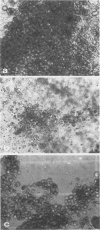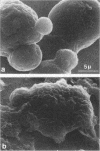Abstract
Trophozoites of Entamoeba histolytica HM-1 were cultivated axenically in TYI-S medium. The amoebae were then transferred into this medium lacking serum (TYI) and inoculated into in vivo colon loops of adult Sprague-Dawley rats. The trophozoites were rapidly absorbed by the mucus, and few were found free in the luminal fluid by 1 h. By 4 h, the amoebae began to reappear in the lumen, aggregated in sloughed mucus blanket fragments. The colon was examined histologically and by scanning electron microscopy. There was no evidence of invasion or even brush-border attachment by the trophozoites within 4 h. In TYI, trophozoite motility was low. Exposure to the colonic lumen environment for 5 min in this medium significantly increased motility. However, as the trophozoites became absorbed to mucus fragments, their observed motility virtually ceased despite some morphological evidence of pseudopod extension. Erythrophagocytosis was not significantly affected by either exposing trophozoites to TYI washings of the colonic lumen, or by the more complete medium, TYI-S, in which the amoebae were significantly more motile. Two major mucus glycoprotein oligosaccharide end-group sugars, L-fucose and N-acetyl-neuraminic acid, were tested for their effects on trophozoite motility in both TYI and TYI-S. L-Fucose reduced motility; the sialic acid increased motility. It is concluded that the intestinal lumen contains several compartments, including the luminal fluid and the mucus blanket, and that Entamoeba trophozoites exist in a highly motile state in the former and a low motility state in the latter. The mucus blanket provided a significant barrier to trophozoite access to intestinal epithelium target tissue.
Full text
PDF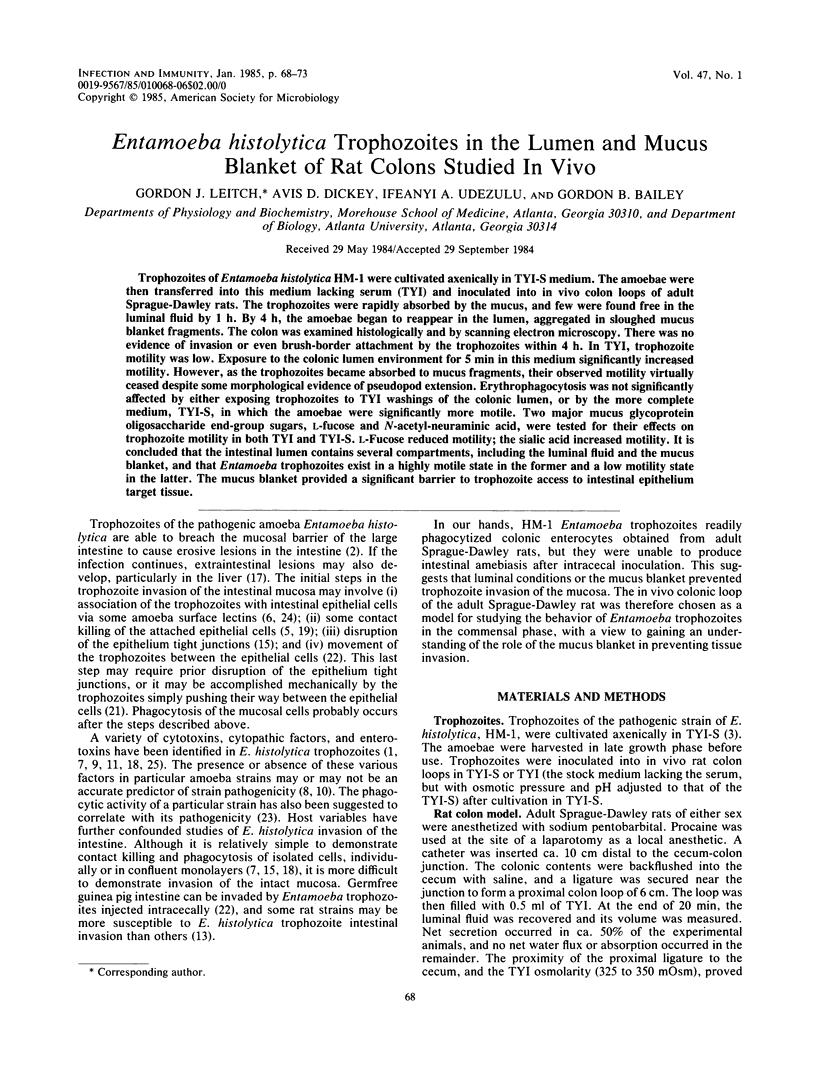
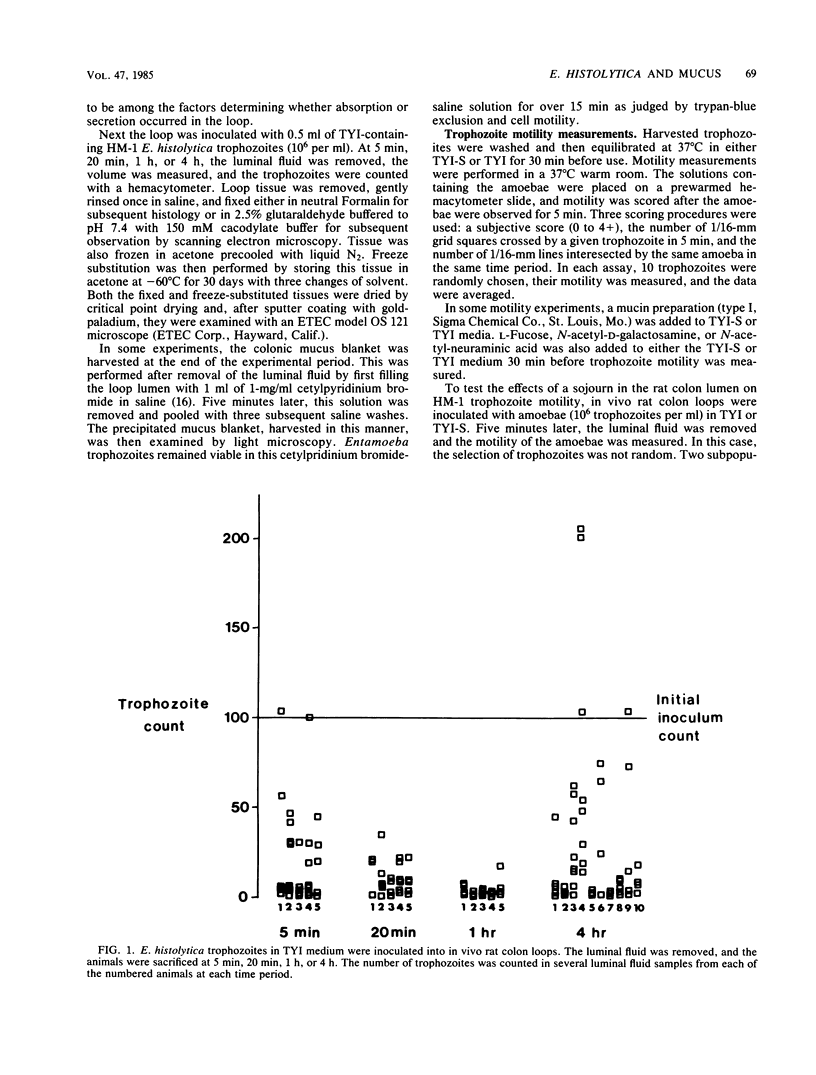
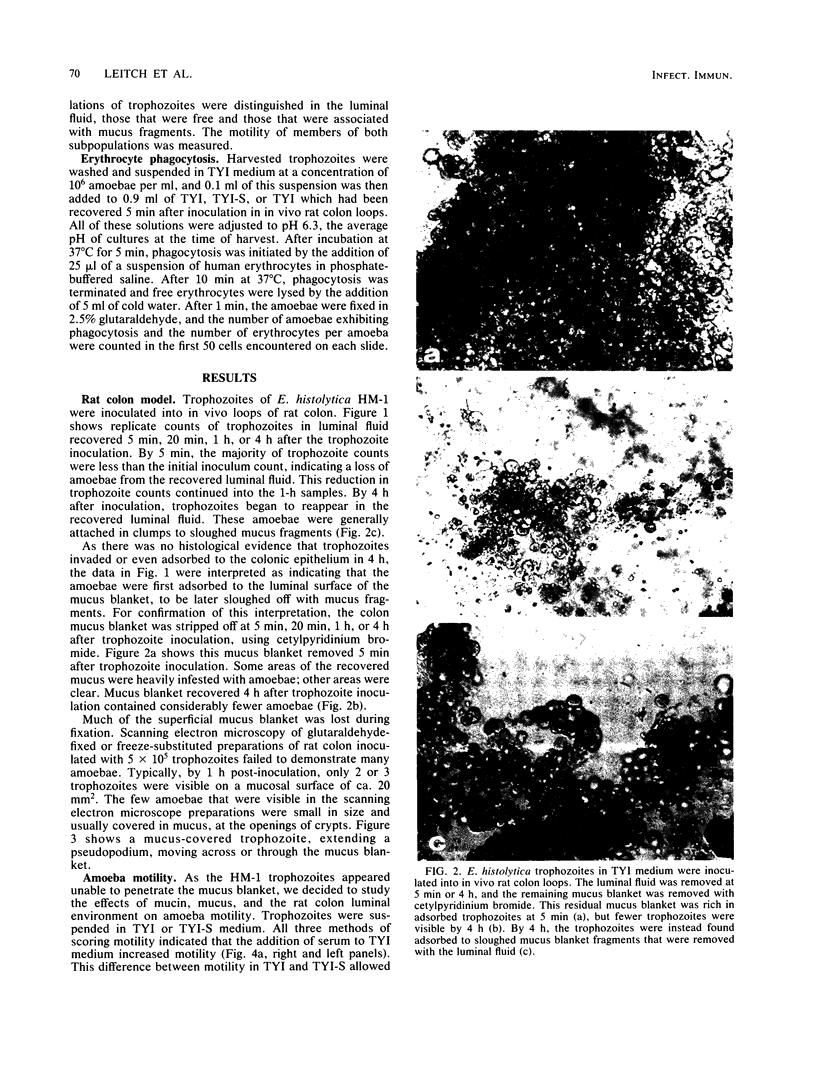
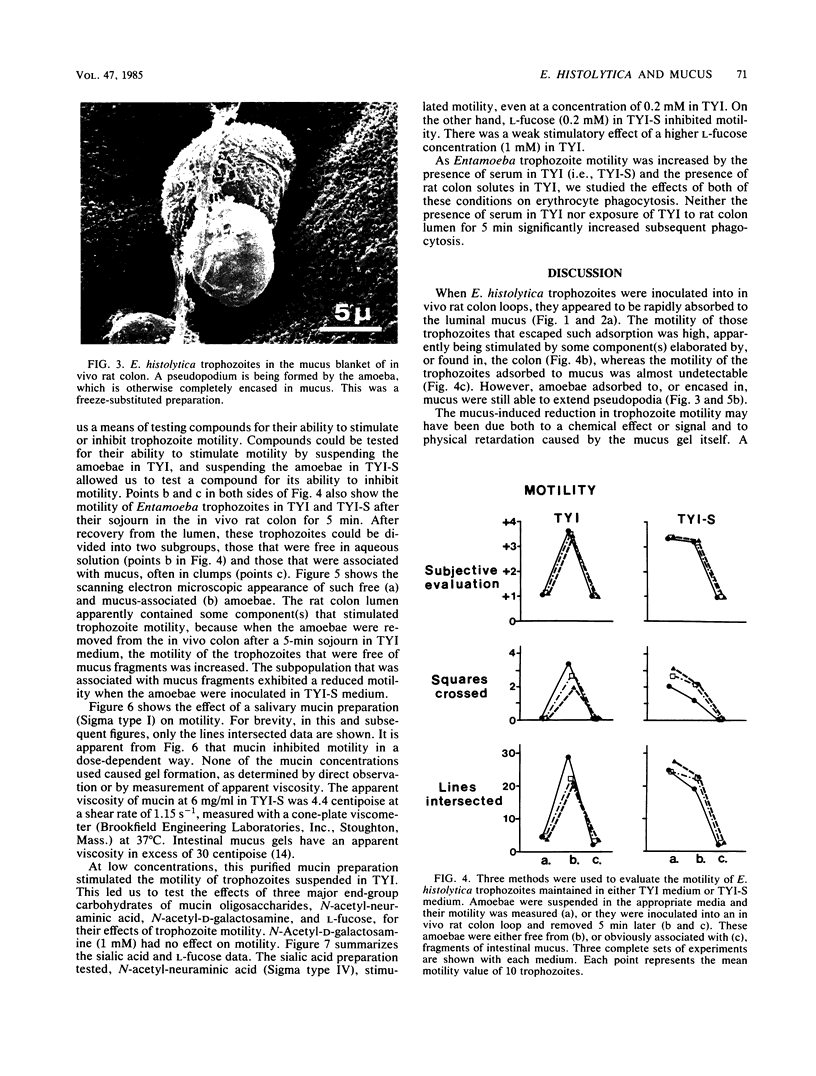
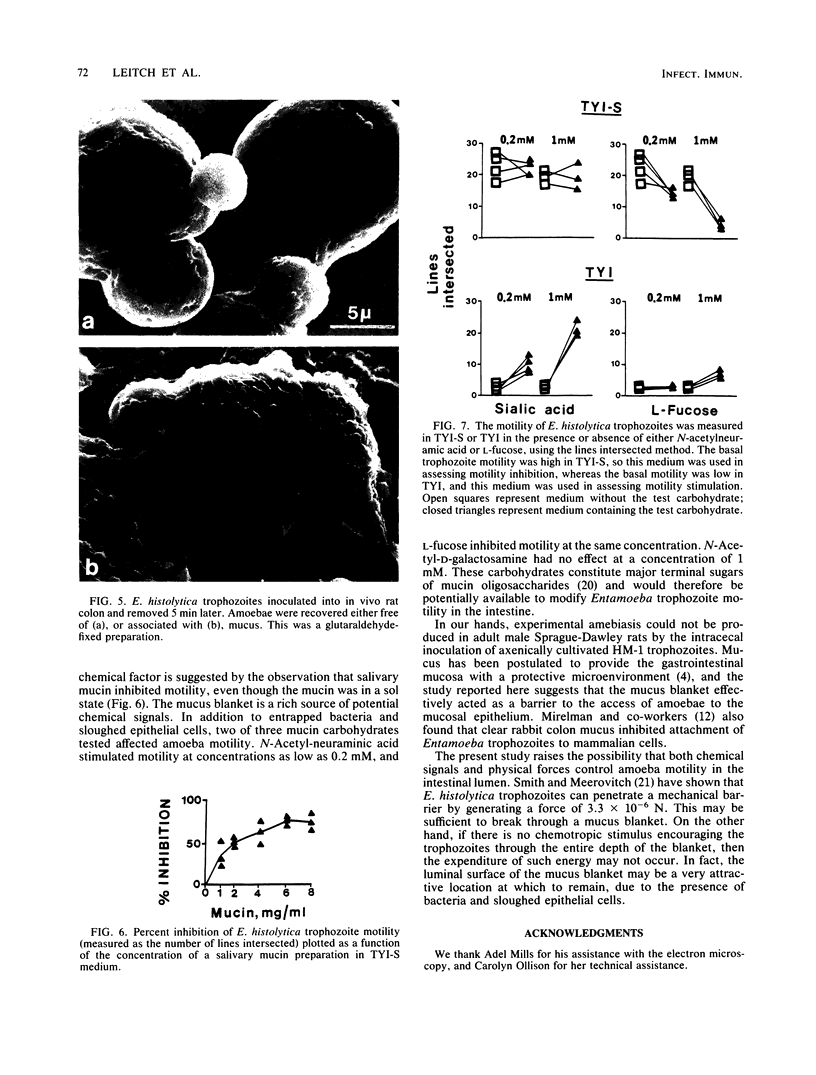
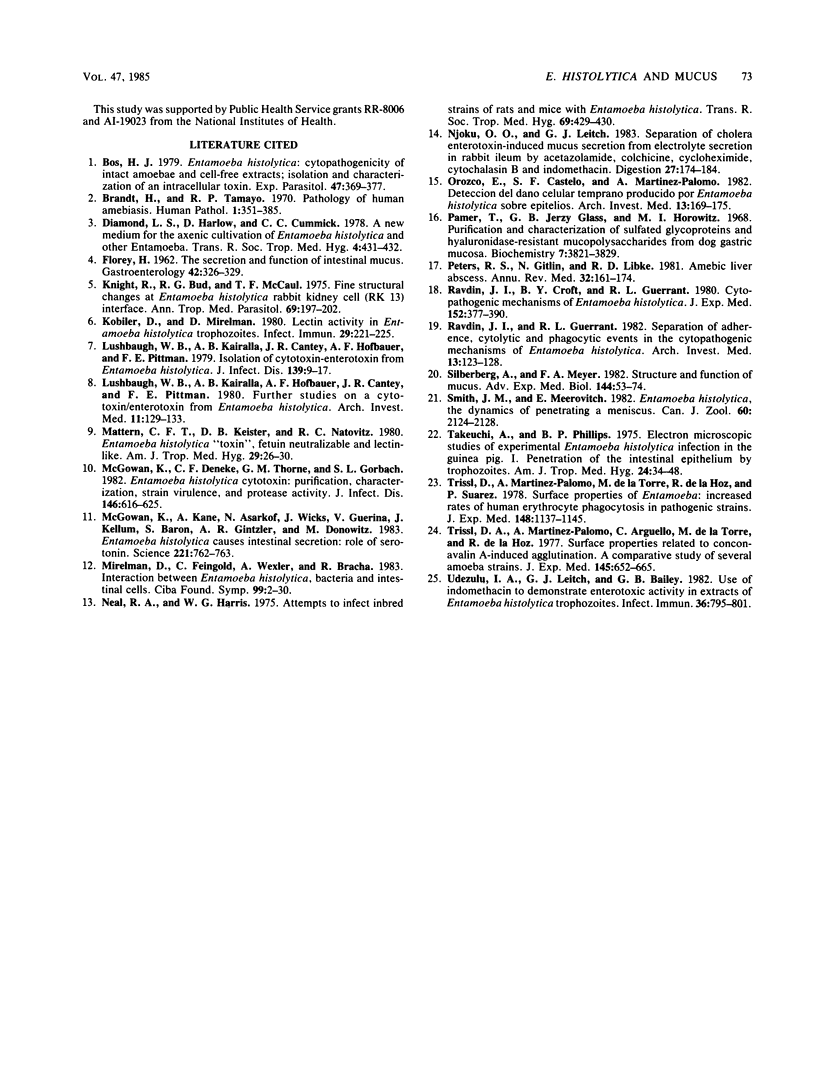
Images in this article
Selected References
These references are in PubMed. This may not be the complete list of references from this article.
- Bos H. J. Entamoeba histolytica: cytopathogenicity of intact amebae and cell-free extracts; isolation and characterization of an intracellular toxin. Exp Parasitol. 1979 Jun;47(3):369–377. doi: 10.1016/0014-4894(79)90089-4. [DOI] [PubMed] [Google Scholar]
- Brandt H., Tamayo R. P. Pathology of human amebiasis. Hum Pathol. 1970 Sep;1(3):351–385. doi: 10.1016/s0046-8177(70)80072-7. [DOI] [PubMed] [Google Scholar]
- Diamond L. S., Harlow D. R., Cunnick C. C. A new medium for the axenic cultivation of Entamoeba histolytica and other Entamoeba. Trans R Soc Trop Med Hyg. 1978;72(4):431–432. doi: 10.1016/0035-9203(78)90144-x. [DOI] [PubMed] [Google Scholar]
- FLOREY H. W. The secretion and function of intestinal mucus. Gastroenterology. 1962 Sep;43:326–329. [PubMed] [Google Scholar]
- Knight R., Bird R. G., McCaul T. F. Fine structural changes at Entamoeba histolytica rabbit kidney cell (RK 13) interface. Ann Trop Med Parasitol. 1975 Jun;69(2):197–202. doi: 10.1080/00034983.1975.11687001. [DOI] [PubMed] [Google Scholar]
- Kobiler D., Mirelman D. Lectin activity in Entamoeba histolytica trophozoites. Infect Immun. 1980 Jul;29(1):221–225. doi: 10.1128/iai.29.1.221-225.1980. [DOI] [PMC free article] [PubMed] [Google Scholar]
- Lushbaugh W. B., Kairalla A. B., Cantey J. R., Hofbauer A. F., Pittman F. E. Isolation of a cytotoxin-enterotoxin from Entamoeba histolytica. J Infect Dis. 1979 Jan;139(1):9–17. doi: 10.1093/infdis/139.1.9. [DOI] [PubMed] [Google Scholar]
- Lushbaugh W. B., Kairalla A. B., Hofbauer A. F., Cantey J. R., Pittman F. E. Further studies on a cytotoxin/enterotoxin from Entamoeba histolytica. Arch Invest Med (Mex) 1980;11(1 Suppl):129–133. [PubMed] [Google Scholar]
- Mattern C. F., Keister D. B., Natovitz P. C. Entamoeba histolytica "toxin": fetuin neutralizable and lectin-like. Am J Trop Med Hyg. 1980 Jan;29(1):26–30. doi: 10.4269/ajtmh.1980.29.26. [DOI] [PubMed] [Google Scholar]
- McGowan K., Deneke C. F., Thorne G. M., Gorbach S. L. Entamoeba histolytica cytotoxin: purification, characterization, strain virulence, and protease activity. J Infect Dis. 1982 Nov;146(5):616–625. doi: 10.1093/infdis/146.5.616. [DOI] [PubMed] [Google Scholar]
- McGowan K., Kane A., Asarkof N., Wicks J., Guerina V., Kellum J., Baron S., Gintzler A. R., Donowitz M. Entamoeba histolytica causes intestinal secretion: role of serotonin. Science. 1983 Aug 19;221(4612):762–764. doi: 10.1126/science.6308760. [DOI] [PubMed] [Google Scholar]
- Mirelman D., Feingold C., Wexler A., Bracha R. Interactions between Entamoeba histolytica, bacteria and intestinal cells. Ciba Found Symp. 1983;99:2–30. doi: 10.1002/9780470720806.ch2. [DOI] [PubMed] [Google Scholar]
- Neal R. A., Harris W. G. Proceedings: Attempts to infect inbred strains of rats and mice with Entamoeba histolytica. Trans R Soc Trop Med Hyg. 1975;69(4):429–430. [PubMed] [Google Scholar]
- Njoku O. O., Leitch G. J. Separation of cholera enterotoxin-induced mucus secretion from electrolyte secretion in rabbit ileum by acetazolamide, colchicine, cycloheximide, cytochalasin B and indomethacin. Digestion. 1983;27(3):174–184. doi: 10.1159/000198948. [DOI] [PubMed] [Google Scholar]
- Orozco M. E., Fernández Castelo S., Martínez Palomo A. Detección del daño celular temprano producido por Entamoeba histolytica sobre epitelios. Arch Invest Med (Mex) 1982;13 (Suppl 3):169–175. [PubMed] [Google Scholar]
- Pamer T., Glass G. B., Horowitz M. I. Purification and characterization of sulfated glycoproteins and hyaluronidase-resistant mucopolysaccharides from dog gastric mucosa. Biochemistry. 1968 Nov;7(11):3821–3829. doi: 10.1021/bi00851a006. [DOI] [PubMed] [Google Scholar]
- Peters R. S., Gitlin N., Libke R. D. Amebic liver abscess. Annu Rev Med. 1981;32:161–174. doi: 10.1146/annurev.me.32.020181.001113. [DOI] [PubMed] [Google Scholar]
- Ravdin J. I., Croft B. Y., Guerrant R. L. Cytopathogenic mechanisms of Entamoeba histolytica. J Exp Med. 1980 Aug 1;152(2):377–390. doi: 10.1084/jem.152.2.377. [DOI] [PMC free article] [PubMed] [Google Scholar]
- Ravdin J. I., Guerrant R. L. Separation of adherence, cytolytic, and phagocytic events in the cytopathogenic mechanisms of Entamoeba histolytica. Arch Invest Med (Mex) 1982;13 (Suppl 3):123–128. [PubMed] [Google Scholar]
- Silberberg A., Meyer F. A. Structure and function of mucus. Adv Exp Med Biol. 1982;144:53–74. doi: 10.1007/978-1-4615-9254-9_6. [DOI] [PubMed] [Google Scholar]
- Takeuchi A., Phillips B. P. Electron microscope studies of experimental Entamoeba histolytica infection in the guinea pig. I. Penetration of the intestinal epithelium by trophozoites. Am J Trop Med Hyg. 1975 Jan;24(1):34–48. doi: 10.4269/ajtmh.1975.24.34. [DOI] [PubMed] [Google Scholar]
- Trissl D., Martínez-Palomo A., Argüello C., de la Torre M., de la Hoz R. Surface properties related to concanavalin A-induced agglutination. A comparative study of several Entamoeba strains. J Exp Med. 1977 Mar 1;145(3):652–665. doi: 10.1084/jem.145.3.652. [DOI] [PMC free article] [PubMed] [Google Scholar]
- Trissl D., Martínez-Palomo A., de la Torre M., de la Hoz R., Pérez de Suárez E. Surface properties of Entamoeba: increased rates of human erythrocyte phagocytosis in pathogenic strains. J Exp Med. 1978 Nov 1;148(5):1137–1143. doi: 10.1084/jem.148.5.1137. [DOI] [PMC free article] [PubMed] [Google Scholar]
- Udezulu I. A., Leitch G. J., Bailey G. B. Use of indomethacin to demonstrate enterotoxic activity in extracts of Entamoeba histolytica trophozoites. Infect Immun. 1982 May;36(2):795–801. doi: 10.1128/iai.36.2.795-801.1982. [DOI] [PMC free article] [PubMed] [Google Scholar]



